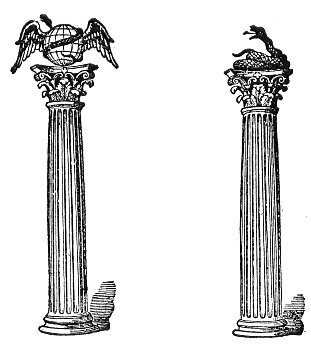Orion, on the same meridian with the Stars of Taurus, died of the sting of the celestial Scorpion, that rises when he sets; as dies the Bull of Mithras in Autumn: and in the Stars that correspond with the Autumnal Equinox we find those malevolent genii that ever war against the Principle of good, and that take from the Sun and the Heavens the fruit-producing power that they communicate to the earth.
With the Vernal Equinox, dear to the sailor as to the husbandman, came the Stars that, with the Sun, open navigation, and rule the stormy Seas. Then the Twins plunge into the solar fires, or disappear at setting, going down with the Sun into the bosom of the waters. And these tutelary Divinities of mariners, the Dioscuri or Chief Cabiri of Samothrace, sailed with Jason to possess themselves of the golden-fleeced ram, or Aries, whose rising in the
p. 467
morning announced the Sun’s entry into Taurus, when the Serpent-bearer Jason rose in the evening, and, in aspect with the Dioscuri, was deemed their brother. And Orion, son of Neptune, and most potent controller of the tempest-tortured ocean, announcing sometimes calm and sometimes tempest, rose after Taurus, rejoicing in the forehead of the new year.
The Summer Solstice was not less an important point in the Sun’s march than the Vernal Equinox, especially to the Egyptians, to whom it not only marked the end and term of the increasing length of the days and of the domination of light, and the maximum of the Sun’s elevation; but also the annual recurrence of that phenomenon peculiar to Egypt, the rising of the Nile, which, ever accompanying the Sun in his course, seemed to rise and fall as the days grew longer and shorter, being lowest at the Winter Solstice, and highest at that of Summer. Thus the Sun seemed to regulate its swelling; and the time of his arrival at the solstitial point being that of the first rising of the Nile, was selected by the Egyptians as the beginning of a year which they called the Year of God, and of the Sothiac Period, or the period of Sothis, the Dog-Star, who, rising in the morning, fixed that epoch, so important to the people of Egypt. This year was also called the Heliac, that is the Solar year, and the Canicular year; and it consisted of three hundred and sixty-five days, without intercalation; so that at the end of four years, or of four times three hundred and sixty-five days, making 1460 days, it needed to add a day, to make four complete revolutions of the Sun. To correct this, some Nations made every fourth year consist, as we do now, of 366 days: but the Egyptians preferred to add nothing to the year of 365 days, which, at the end of 120 years, or of 30 times 4 years, was short 30 days or a month; that is to say, it required a month more to complete the 120 revolutions of the Sun, though so many were counted, that is, so many years. Of course the commencement of the 121st year would not correspond with the Summer Solstice, but would precede it by a month: so that, when the Sun arrived at the Solstitial point whence he at first set out, and whereto he must needs return, to make in reality 120 years, or 120 complete revolutions, the first month of the 121st year would have ended.
Thus, if the commencement of the year went back 30 days every 120 years, this commencement of the year, continuing to
p. 468
recede, would, at the end of 12 times 120 years, or of 1460 years, get back to the Solstitial point, or primitive point of departure of the period. The Sun would then have made but 1459 revolutions, though 1460 were counted; to make up which, a year more would need to be added. So that the Sun would not have made his 1460 revolutions until the end of 1461 years of 365 days each,–each revolution being in reality not 365 days exactly, but 365¼.
This period of 1461 years, each of 365 days, bringing back the commencement of the Solar year to the Solstitial point, at the rising of Sirius, after 1460 complete Solar revolutions, was called in Egypt the Sothiac period, the point of departure whereof was the Summer Solstice, first occupied by the Lion and afterward by Cancer, under which sign is Sirius, which opened the period. It was, says Porphyry, at this Solstitial New Moon, accompanied by the rising of Seth or the Dog-Star, that the beginning of the year was fixed, and that of the generation of all things, or, as it were, the natal hour of the world.

Moe is the founder of GnosticWarrior.com. He is a father, husband, author, martial arts black belt, and an expert in Gnosticism, the occult, and esotericism.






